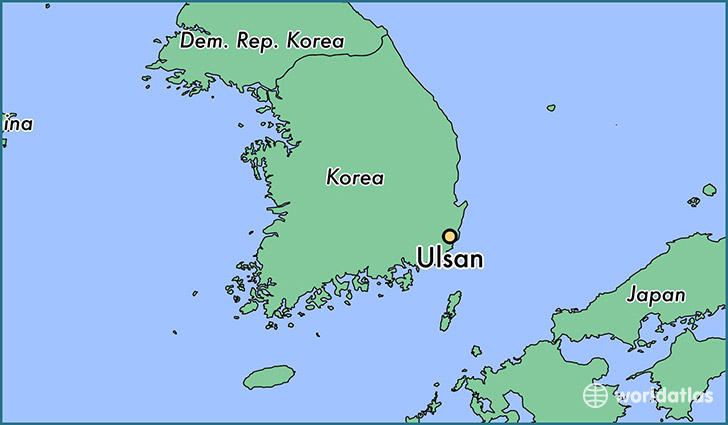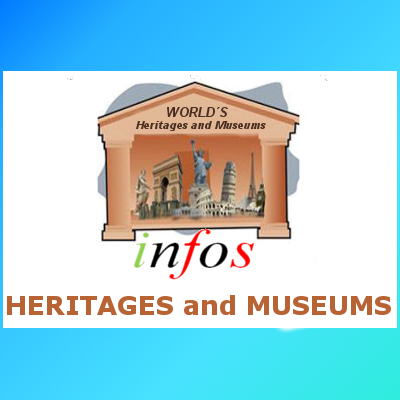Map of Ulsan- South Korea

Ulsan, officially the Ulsan Metropolitan City, is South Korea’s seventh largest metropolis with a population of over 1.1 million. It is located in the south-east of the country, neighboring Busan to the south and facing Gyeongju to the north.
Ulsan is the industrial powerhouse of South Korea, forming the heart of the Ulsan Industrial District, which is home to the world’s largest automobile assembly plant operated by the Hyundai Motor Company, the world’s largest shipyard operated by Hyundai Heavy Industries and the world’s second largest oil refinery, owned by SK Energy. In 2012, Ulsan had a GDP per capita of $79,623, the highest of any region in South Korea.
Population: 1.124 million (2014)
Language
The main language spoken in South Korea is Korean. (English widely taught in junior high and high school)
Religion:
Christian 26.3{bdfd6398e3e766e1d125b289e0be62f43c2c43a617b3a55edb76ed4862b690cd}} (Protestant 19.7{bdfd6398e3e766e1d125b289e0be62f43c2c43a617b3a55edb76ed4862b690cd}, Roman Catholic 6.6{bdfd6398e3e766e1d125b289e0be62f43c2c43a617b3a55edb76ed4862b690cd}), Buddhist 23.2{bdfd6398e3e766e1d125b289e0be62f43c2c43a617b3a55edb76ed4862b690cd}, other or unknown 1.3{bdfd6398e3e766e1d125b289e0be62f43c2c43a617b3a55edb76ed4862b690cd}, none 49.3{bdfd6398e3e766e1d125b289e0be62f43c2c43a617b3a55edb76ed4862b690cd}
Currency
South Korean Won (KRW)
Geography
Ulsan is bounded on the east by the Sea of Japan (East Sea). Busan is 70 km to the south.
Climate
Ulsan has a monsoon-influenced humid subtropical climate (Köppen Cfa/Cwa), with somewhat cold but dry winters, and hot, humid summers. Monthly means range from 2.0 °C (35.6 °F) in January to 25.9 °C (78.6 °F) in August, with diurnal temperature ranges generally low. Its location on the Korean peninsula results in a seasonal lag, with the warmest days being in August and averaging very near 30 °C (86 °F). Precipitation is relatively low in the winter months, but is made up by the high rainfall falling from April to September.
Economy
Ulsan Central market entrance
As the center of the Ulsan Industrial District, the city is the corporate base of the multinational Hyundai conglomerate. Up to 1962, Ulsan operated as a fishing port and market centre. As part of South Korea’s first five-year economic plan, Ulsan became an open port. Additionally, major industrial plants and factories were developed, including in particular an oil refinery, fertiliser plants, automobile production and heavy industries. The shipbuilding port Bangeojin became part of the city in 1962.
Ulsan is currently the home of the world’s largest automobile assembly plant operated by Hyundai Motor, the world’s largest shipyard, operated by Hyundai Heavy Industries and the world’s second largest[citation needed] oil refinery owned by SK Energy.
Transportation
The city transport department plans to build a light-rail line and the public transportation system is as good as any other major Korean city. The bus system shows a particular ETA at most bus stops. Ulsan Airport, constructed in 1970 and expanded in 1997, has more than 20 flights per day to and from Seoul’s Gimpo International Airport and 4 flights per week to and from Jeju International Airport. In November 2010, Korea’s high-speed train network, the KTX, was extended to Ulsan. This provides a high-speed link to Seoul, with a running time of just over 2 hours. The new KTX station (Ulsan Station) is in nearby Eonyang, with a series of express buses (5001-5004) as well as some city buses serving the new station. The original city station has been renamed Taehwa River Station.
Tourist attractions
Yeongnam Alps
There are 7 tall mountains (Gajisan, Sinbulsan, Ganwolsan, cheonhwangsan, yeongchuksan, Goheonsan, Jaeyaksan) over 1,000m above sea level. Sinbulsan (MT.) Ridge, which changes to a fantastic silver grass field in autumn, is one of the best sights to see in the Yeongnam Alps. Eoksae festival is held every early October in Ganwoljae which is best known for its colony of silver grass.
Oegosan Onggi village
Korea’s largest traditional folk Onggi (earthware) village creates a unique scene as the whole village is made of earthware. You can see the first-hand traditional Onggi (earthware) manufacturing process including Onggi workshops and kilns. Try your hand at making Onggi. The Ulsan Onggi museum offers a variety of information related to Onggi and displays a diversity of this eathware.
Jangsaengpo Whale museum & Whale Ecological Experience Hall
As the only whale museum in Korea, Jangsaengpo whale museum collects, maintains and displays whailing-related artifacts, which have been disappearing since 1986 when whailing was prohibited. It also provides a variety of information related to whales and marine ecosystems and is a space for education, research and experience. And You can enjoy ride on whale cruise from Jangsaengpo port.
Grand Parks
Ulsan Grand Park , it is the best ecology park in a downtown area in Korea, boasting a vast area of 3,640,000 m2 (39,180,634 sq ft). With Natural, Clean and comfortable as the main themes, it is a pleasant place for relaxaion where you can breathe in nature during daily life. This Peaceful and pleasant downtown park is always filled with family visitors as it hosts a variety of experience events and festivals. In particular, the Rose Festival in every June presents the opportunity to enjoy a feast for the eyes with diversity of beautiful roses.
Taehwagang River Grand Park : Simnidaesup (bamboo grove), one of the 12 scenic beauties of Ulsan, was restored and now the river and the bamboo grove are connected. it is an ecological space that reminds citizens of the importance of nature and environment. It allows visitors the chance to observe and experience wildlife in its natural environment and to relax while being one of nature.
Industrial tour
Ulsan Industry Park, emitting its dazzling lights 365 days a year, has been leading the Pacific Rim industry in the 21st century. Ulsan Has Hyundai Motor Company, with the world’s largest single-purpose plant, Hyundai heavy Industries, the biggest heavy industry leader in the world, Hyundai Mipo Shipbuilding, Petrochemical Park, leaders in Korea’s chemistry industry.
Coast trip
Ulsan has beautiful beaches (Jinha, Ilsan) and amazing view of Daewangam Park with its lush hundred-year-old pine forest. Specially, Ganjeolgot cape tops the list as the best-known sunrise site, where the sun rises first on the Korean peninsula. A sunrise festival is held every New Year’s Day.










